I’m kind of a PFD snob. Since my early paddling days in the 1970s when we had to make wearable PFDs from kits or buy the only one then manufactured, which was made by Extrasport, I’ve tried almost everything on the market.
When I was scuba diving for the Navy in the late ’60s and early ’70s, I wore an inflatable that was manually or CO2-cartridge activated. Such flotation devices led to today’s divers’ buoyancy compensators and Type-V PFDs. These inflatable PFDs, made as suspenders or a belt with a pouch, are very compact, but once they are inflated you can neither swim effectively nor do anything else useful to help yourself if you’ve gone overboard; all you can do is wait for help. For those of us who sail and row, they can also get caught on gear such as rigging or oar handles. I wear a waist-band inflatable for summer rowing and sailing in benign conditions but, while it doesn’t catch on stuff, I’m reluctant to inflate it because it would get in the way of any self-rescue procedures. However, without some buoyancy, if capsized, I would need to devote some of my recovery efforts to keeping myself afloat.
The early life vests that used foam for flotation were the precursors to Type III PFDs, which are designed to keep you afloat any time you’re in the water and don’t make it impractical to swim. They can also have lots of pockets in which to carry gear. But, the bulk of the foam can interfere with your ability to climb back aboard after a capsize, or reach well aft at the catch of a rowing stroke, and they can crowd the oar handles at the finish of the stroke. The pockets, empty or full, can further add to the interference at the end of the stroke.
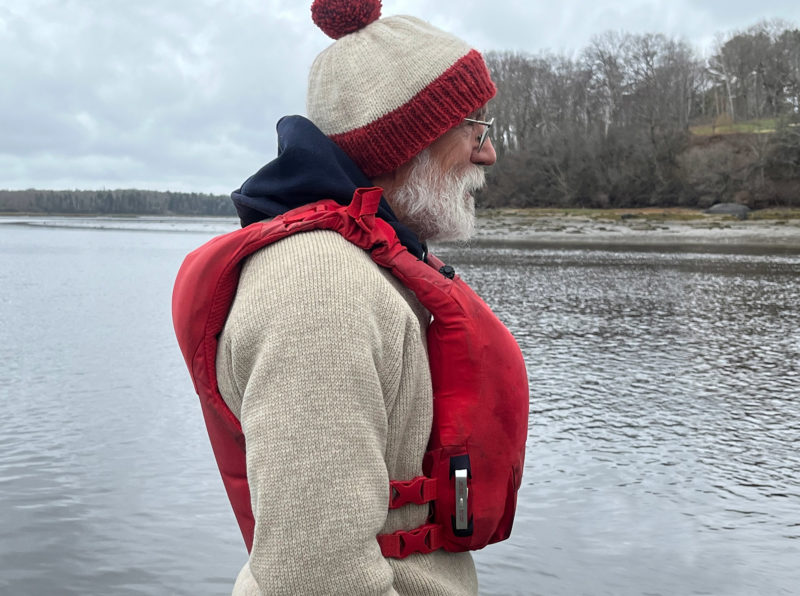 Photographs by Marti Wolfe
Photographs by Marti WolfeThe Khimera has a large front bladder and a smaller one in the back above the shoulder blades. Both can be inflated either by triggering the CO2 cartridge with the pull-handle, lower right, or orally via a tube tucked into the front of the PFD at the neck opening. The black cap of the inflation tube is visible here at the base of the shoulder strap.
Enter Mustang Survival’s Khimera, a hybrid foam/inflatable Type V PFD. I first saw one in 2019 at a spring fishing trade show as part of a National Marine Fisheries Service effort to reduce fishing deaths by drowning. I was impressed by it and bought one.
The Khimera’s foam provides 7.5 lbs of buoyancy and its air bladders add 13 lbs when inflated, for a total of 20.5 lbs. (The minimum buoyancy for a foam Type III is 15.5 lbs.) Like other inflatables, the Khimera has a Type V classification, which means that you have to wear it, not just have it on board, for it to meet U.S. Coast Guard requirements. Mustang also classifies the Khimera as a Level 70 Buoyancy Aid, which provides a minimum buoyancy of 70 Newtons (15.7 lbs) and notes: “Level 70 buoyancy aids are intended for use by those who have a means of rescue close at hand, or who are near to bank or shore. These devices have minimal bulk, but cannot be expected to keep the user safe for a long period of time in disturbed water.”
The front of the over-the-head-entry Khimera is smooth with only one small pocket, so there is nothing likely to catch on gear. The pocket is meant to carry an extra CO2 cylinder; I use it to carry ID and a Greatland Laser rescue flare as well. It would fit a modest-sized waterproof cell phone, but could be a tight squeeze for a cell phone in a waterproof pouch. I have a big storm whistle lashed to a shoulder strap, and I clip a VHF to the other shoulder strap or the front of the jacket with a lanyard to the shoulder strap, with enough slack to easily operate the radio. When I want to carry a personal EPIRB I fasten it to one of the lash tabs on the shoulder straps.
One of my Greenland-style paddling friends tried my Khimera. He has mastered the full repertoire of Greenland rolls, which require extraordinary flexibility and a range of motion unrestricted by a bulky foam PFD. He bought a Khimera; the only PFD that would give him more mobility would be a waist-belt inflatable PFD.

The Khimera comes in only one size, but has adjustable shoulder and side straps. The front pocket is slim, so unlikely to catch on gear or oar handles, but also large enough to hold a spare cartridge, flare, or compact waterproof cell phone.
After seeing how well the Khimera worked for me, my rowing partner just picked one up because it provides more warmth than a belt inflatable in cool weather, and doesn’t snag oar handles. It is also far better suited to leaning forward and back during a long rowing stroke than paddling-oriented full-foam PFDs. My jacket is red, which is okay for visibility, and has red retroreflective lash tabs. My partner’s is a nice robin’s egg blue—which has very good visibility at sea—and green retroreflective lash tabs.
Last fall, on a chilly late October Maine day, I had an unplanned opportunity to test the Khimera. I was paddling my small wood/canvas canoe, trying fancy freestyle turning strokes, made a mistake, and over I went. It was not a great day for a dip. I needed to get out fast and get the water out of the canoe. I shook much of the water out of the boat, then grabbed the painter and swam the short distance to an island where I emptied the rest. The Khimera’s foam provided me with enough flotation that I could right, bail, and tow without having to tread water to stay afloat—it wasn’t necessary to inflate the air bladders. In retrospect, the 8 lbs of buoyancy floated me about the same as a full-thickness wet suit, enough to keep me safely afloat. I didn’t even think about needing the additional buoyancy of the inflatable bladders. I had a mile or so of pretty chilly paddling home. While I was wearing wool, I wasn’t dressed for immersion. The Khimera kept my core warm and, indeed, has done so when rowing throughout four Maine winters.
The jacket is “one size fits all” with side and shoulder adjustment straps. The straps have clever elastic loops that allow you to roll up excess length and tuck it neatly away. After nearly four years, the elastic has lost its springiness, and I’ll soon be taking a few stitches with the sail needle to tighten them.
The Khimera is inflated either by a CO2 device triggered by a pull handle on the right side or an oral inflation tube tucked behind the PFD’s front. The large bladder in the front is connected through the shoulder straps to a smaller one in the back. The larger front bladder favors floating face-up, and the rear bladder raises your back to make it easy to hold your head upright. The bladders are fully contained by the jacket, so they just need to be flattened before the Khimera’s next use. The suspenders- and belt-style PFDs are more persnickety and need to be carefully refolded. With both my Khimera and waistband inflatable I trigger the CO2 mechanism at the beginning of the season and rearm it with a new cartridge.
The Khimera would be warmer than the belt or suspenders-style inflatable on hot summers, but with about half the amount of foam of a typical Type III PFD, it would be cooler than those more commonly used styles. When I’m paddling rocky whitewater or playing near rocks in kayaks I don a conventional Type III for its padding, pockets, and additional foam flotation. But for lake paddling and inshore rowing and sailing, the Khimera gets the call.![]()
Ben Fuller, curator emeritus of the Penobscot Marine Museum in Searsport, Maine, and former curator of Mystic Seaport and Chesapeake Bay Maritime Museum, has been messing about in small boats for a very long time. He is owned by a dozen or more boats ranging from an International Canoe to a faering.
The Mustang Khimera Dual Flotation PFD is available from Mustang Survival, priced $239.99.
Is there a product that might be useful for boatbuilding, cruising, or shore-side camping that you’d like us to review? Please email your suggestions.
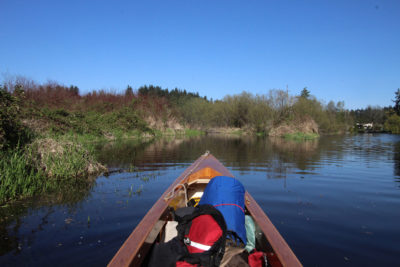
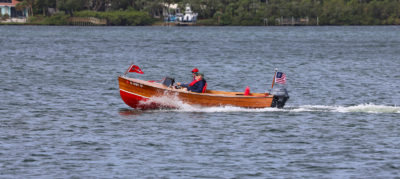
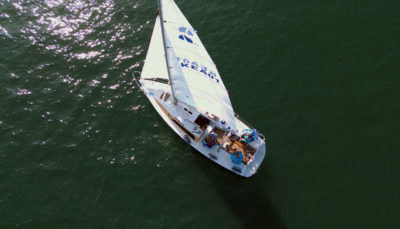
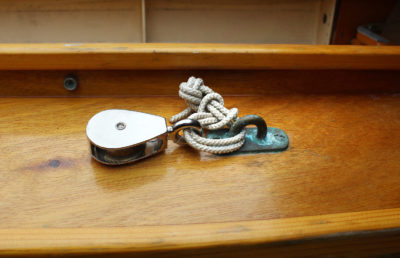
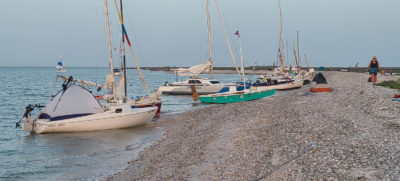
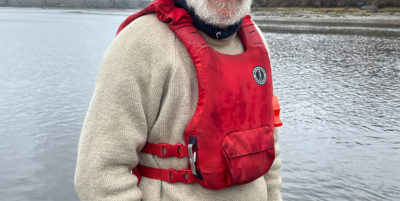
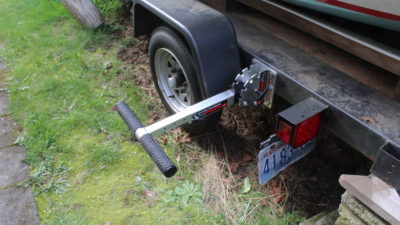
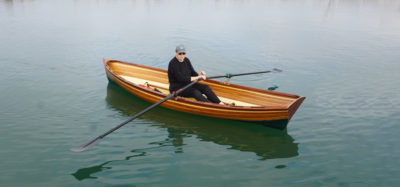
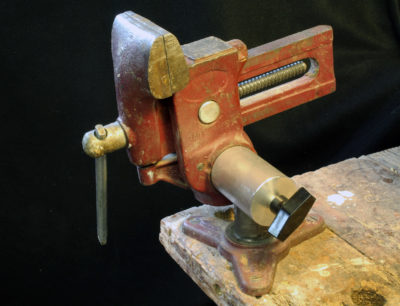
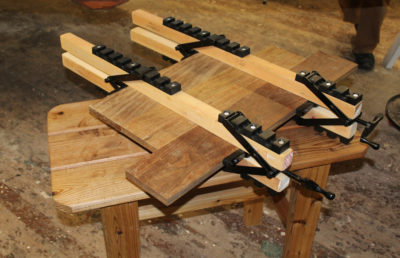
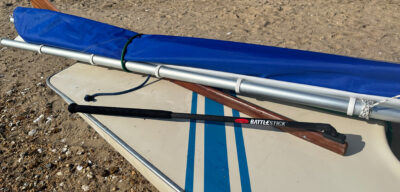
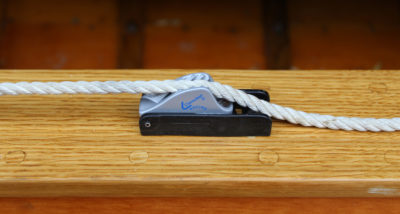
I had been waffling between this and suspenders, but you made the case. Just got one!
Ben,
I just picked up one from West Marine on sale. I’m trying to remember where I saw your comments about an open-mesh vest with pockets to go over it.
Regards,
Mike